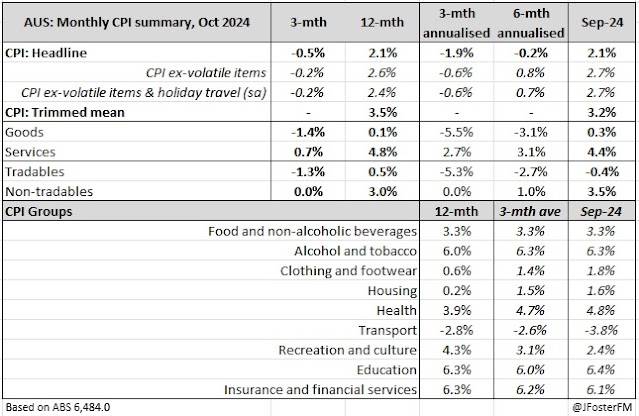Australian headline CPI inflation came in at an unchanged 2.1%yr on the ABS's monthly indicator in October, defying expectations for an upside drift to 2.3%. Government rebates on electricity bills and lower fuel prices are driving disinflationary progress, taking headline CPI down from a 3.8% pace in June. In spite of this, reduced rate-cut expectations in the US and solid domestic labour market data have seen the RBA outlook hawkishly repriced where markets have pushed back the timing of a rate cut well into 2025.
Headline CPI remained at lows back to July 2021 after holding at 2.1% in October. Base effects were expected to see CPI firm to 2.3%; however, prices fell 0.3% in the latest month - matching the decline from 12 months ago - on federal and state government electricity rebates and lower fuel prices. The disinflationary impulse from these components is reflected in headline CPI falling in both 3-month (-1.9%) and 6-month (-0.2%) annualised terms.
Electricity prices have fallen by 35.6% over the year - the most on record - while fuel prices are down 11.5%yr. Other volatile price categories showed only limited movement in October: food and non-alcoholic beverages holding at 3.3%yr and alcohol and tobacco softening to 6.0%yr from 6.3%yr in September.
Underlying price pressures showed mixed progress across the various measures. CPI ex-volatile items ticked down from 2.7% to 2.6%yr, while a broader, seasonally adjusted measure that also removes holiday travel eased from 2.7% to 2.4%yr - its slowest pace since November 2021. The softer readings on these gauges contrasted with a firming in the trimmed mean CPI from 3.2% to 3.5%, a reversal of recent progress to print at its highest since July.
The more elevated pace on the underlying gauges relative to headline CPI remains underpinned by services inflation, which firmed from 4.4% to 4.8%yr on the back of increases across rents (6.7%yr), holiday travel (8%yr) and insurance and financial services (6.3%yr).
This contrasts with substantial disinflation in goods prices to 0.1%yr, of which electricity and fuel are key components. The October report contained only limited updates on services prices, but the overall dynamics of services inflation and goods disinflation are the same as what central banks in many other advanced economies are contending with.






